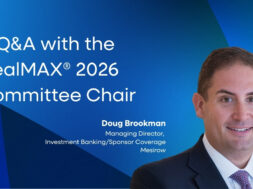Middle-Market Public Policy Roundup
The IRS released the long-awaited guidance on opportunity zones and ACG attended a White House conference where officials, including President Donald Trump, voiced support of the program.

Investors are continuing to make sense of the various regulations and incentives offered by the opportunity zones program this week after a flurry of activity stemming from the release of new guidance by the IRS and overtures made by the White House to support and supervise the tax reform initiative.
ACG attended a White House conference on the program last week around the same time the Treasury Department released its second round of guidance. Treasury also requested information it will use to track the progress of the program.
Finally, the White House Opportunity and Revitalization Council also published its implementation plan for the program, which looks to coalesce federal agencies around various “work streams” focused on issues that include economic, educational and workforce development.
ACG Attends White House Opportunity Zones Conference
Last Wednesday, ACG staff attended a White House conference on opportunity zones for state, local, tribal and community leaders. Attendees heard from several high-ranking government officials, including President Donald Trump, Treasury Secretary Steven Mnuchin, Housing and Urban Development Secretary Ben Carson and National Economic Council Director Larry Kudlow.
During his remarks, President Trump highlighted the private capital investment and community revitalization the White House expects opportunity zones will create. He also highlighted the newly formed White House Opportunity and Revitalization Council, which was created to streamline, coordinate and target existing federal programs toward economically distressed areas and opportunity zones.
Most of the speakers expressed substantial optimism toward the opportunity zones program and the myriad benefits it can produce. Topics explored in the general session included a focus by the administration to prioritize flexibility and incentives to spur reinvestment and the intent to centralize and harmonize federal programs to assist community development in opportunity zones.
Other takeaways from speakers included their strong desire to shape the existing program and resources toward opportunity zones, and a desire to address workforce development and affordable housing needs.
During the invite-only conference, ACG participated in two breakout sessions on empowering entrepreneurship within opportunity zones and federal guidance surrounding the program. These breakout sessions were designed to facilitate discussion among private sector, state-level government and federal staff on key issues related to the opportunity zone program.
Treasury Announces Second Round of Opportunity Zone Guidance
Treasury announced the second round of proposed guidance for opportunity zones on April 17, in tandem with the White House conference, as a follow-up intended to address comments and provisions left unclear from the initial guidance released in October of last year. Similar to the last proposal, the proposed regulations were designed to be investor-friendly and as flexible as possible within the statutory limitations created by the law.
A significant number of questions left unresolved in the first go-around were addressed in the proposal, including the 50% gross income requirement, issues surrounding leased property, and what is included in the 90% asset test that funds must undergo.
50% Gross Income Requirements
A topic of concern among the private sector and lawmakers was the “50 percent requirement” in the law that required a company to derive half of its gross income from business conducted within a qualified opportunity zone in order to qualify as an opportunity zone business.
The guidance now provides a safe harbor for businesses whose employees and contractors perform 50% of their services—which is based on hours or the amount paid to employees—in a qualified opportunity zone. Further safe harbor protection is provided to companies whose tangible business property is in an opportunity zone and whose operational or management functions required that at least 50% of gross income be located within an opportunity zone. Additional safe harbors may apply based on a “facts and circumstances” test.
Leased Property
Property leases entered after Dec. 31, 2017 qualify to be treated as an opportunity zone business property if substantially all of the tangible property is located in an opportunity zone during substantially all of the period it is leased. There is also no “original use” requirement and a property may be acquired from a related lessor, allowing businesses to transition properties by leasing them to related entities. To qualify, property must be leased at a “market rate.” Prepayment of the lease must not exceed 12 months for related lessors.
Leased tangible personal property—defined as personal property that can be physically relocated—have different restrictions and improvement requirements.
90% Semi-Annual Testing, Reinvestments and New Investments
The guidance clarifies that qualified opportunity funds will have both newly invested capital (with a six-month exemption) and proceeds from the sale of a qualified opportunity zone property or business (12-month exemption) excluded from the “90 percent asset test.” The test dictates that 90% of a qualified opportunity fund must be invested in qualified opportunity zone property or businesses, and will be verified every six months.
Carried Interest
Carried interest in a qualified opportunity fund in return for services offered to the fund does not qualify for the preferential tax treatment provided by opportunity zones.
Debt-Financed Distributions
Distributions not in excess of the investor’s basis in the qualified opportunity fund may be debt-financed.
Triple Net Leases
Triple net leases will not qualify as the active conduct of an opportunity zone trade or business.
In addition to other issues, the guidance also addresses REIT asset transfers, questions surrounding “substantial improvement” and “substantially all” tests, transfers upon death and many others. The full guidance is available here.
Treasury Requests Information on Data Collection and Tracking for Qualified Opportunity Zones
In addition to the proposed guidance, Treasury also announced a request for information on the development of information collection and tracking for opportunity zone investments in order to help achieve optimal tracking of the effectiveness and investor-attractiveness of opportunity zones.
Other questions include what data would be useful for tracking the effectiveness of the opportunity zones tax incentives, what costs and benefits should be taken into account when considering various methods of information collection, and what factors should be included when examining data on the effectiveness of the opportunity zones program.
The full request for information is available here.
White House Opportunity and Revitalization Council Publishes Implementation Plan
Also on Wednesday, the White House Opportunity and Revitalization Council published its “Implementation Plan” outlining a detailed plan of work pursuant to executive order 13853, which created the council, named its member-agencies, and established its core focuses.
The implementation plan creates “Council Work Streams” to establish lead and supporting agencies focused around the specific issues of measuring entrepreneurship, safe neighborhoods and economic, educational and workforce development.
In coming months, the council will be conducting a listening tour across various opportunity zones, reviewing federal programs that can assist with opportunity zones, developing a uniform opportunity zone “training manual” and best practices, and aggregating a list of various federal programs that can assist with opportunity zone communities.
Are you an ACG member who enjoys reading the public policy roundup? Join our Public Policy Interest Group to receive even more in-depth coverage of federal policy activity impacting the middle market, as well as opportunities to help shape ACG’s advocacy efforts.

Maria Wolvin is ACG Global’s vice president and senior counsel, public policy.

Ben Marsico is ACG Global’s manager of legislative and regulatory affairs.


